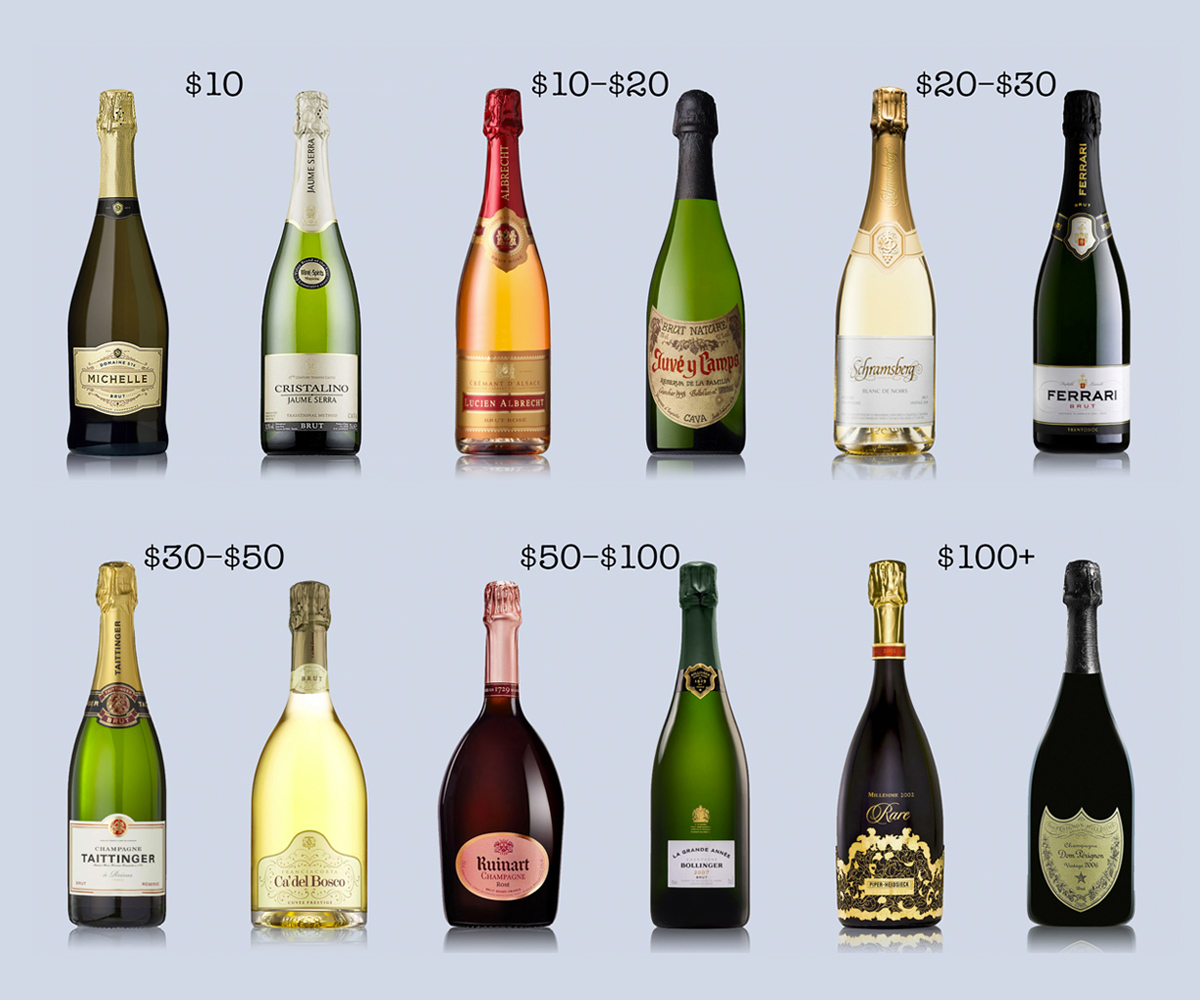There’s no doubt about it: trying to find the best Champagne is intimidating. While it’s exciting to traipse through the sparkling wine aisle, it can turn stressful pretty fast when you see the French names, opulent branding, and hefty price tags. You ask yourself,
“How much should I be paying? Is it any good? Will people actually like it?”
You panic, grab the prettiest label, and speed off to your celebration, hoping it tastes as good as it looks.
The Best Sparkling Wine on Any Budget
This helpful guide is full of tips and tricks on avoiding common bubbly-buying mishaps and getting a great taste for your dollar.
Table of Contents
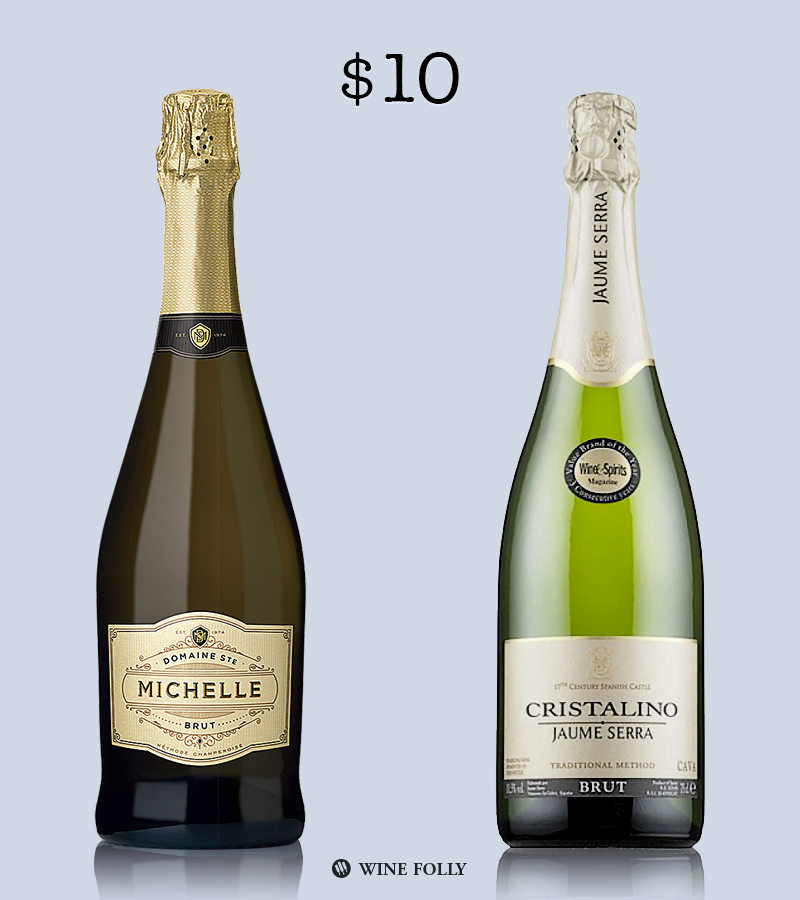
$0–$10 – Mass Consumption
So, you’re buying for a crowd. Or you’re switching out your PBR for something more special. Or maybe you just need to bring something.
I’m not going to lie; it’s not easy to find quality in this price range!
When you do find bubbly in this price range, frequently, it’s the sweeter kind. The kind that causes a headache.
Still, there are a few affordable gems from lesser-known regions and producers who have mastered efficiency and flavor. The first to come to mind: Spain and their lean and lively version of bubbly, Cava.
What To Seek Out: Cava, Prosecco, Domestic Sparklers
Some Helpful Tips
- When in doubt, go with Cava for an excellent quality-to-value pick.
- Make sure the wine is Brut or Extra Brut to avoid headaches (unless it’s Prosecco).
- Keep in mind that wines made with the tank method (like Prosecco) are significantly less bubbly than real Champagne—by 3-4 atmospheres of pressure.
- Look to regions not named Champagne but still producing wine through the same method. Look for labels that have Traditional Method, Metodo Classico, Méthode Champenoise, or Méthode Classique on them.
- Love Prosecco? Great! Base model Prosecco shouldn’t be more than $12.
A Few Examples
- Jaume Serra Cristalino Brut Cava
- Paul Cheneau “Lady of Spain” Brut Cava
- Domaine Ste. Michelle Brut Washington Sparkling Wine
- Riondo “Spago Nero” Extra Dry Prosecco
- Lunetta by Cavit Brut Prosecco

$10–$20 – Basic, But Delicious
Now we’re closer to the great Champagne. If you’re looking for a good sparkler for a good price, this is your sweet spot. You’ve found a crowd-pleaser – a drink you’ll toast to and want to keep in your mouth. You bring this to share with your friends, and it shows you care. Who’s the MVP of the party? You are (or at least you will be.) No, you won’t find any real Champagne here. Not the biscuity, nutty, rich, or aged flavors that come with extended aging.
What you will get are outstanding fresh, fruity, drink-now sparklers that pair with a surprising number of bites. Though, if you play it smart, you might find a decent “Reserva” Cava or creamy South African or domestic bubbly that will surprise you!
What You Get: Crémant (Good), Prosecco (Good), Domestic Sparklers (Good), Cap Classique (Good), Cava Reserva (Good-Great), Sekt (Decent)
Some Helpful Tips
- Great finds abound in lesser-known regions. (Cap Classique from South Africa; Sekt from Germany/Austria; Cava from Spain).
- Crémant is the more gentle, affordable French alternative to Champagne. Learn more about Crémant.
- Like it sweet and fruity? Look for Rosé, Cap Classique, Prosecco, or the term “Extra-Dry.”
- Sweet and fruity wines are great for stand-alone drinking, toasts, and as an apéritif.
- Like it lean and dry? Go with Brut, Extra Brut, and Brut Nature styles or Cava.
- Dry styles are great for pairing with foods. (Nom nom.)
A Few Examples
- Treveri Brut “Blanc de Blancs” Washington Sparkling Wine
- Gruet “Blanc de Noirs” Brut New Mexico Sparkling Wine
- Gloria Ferrer “Blanc de Noirs” Carneros Sparkling Wine
- Graham Beck Brut Cap Classique
- Antech Brut Crémant de Limoux
- Louis Bouillot “Perle d’Aurore” Brut Rosé Crémant de Bourgogne
- Lucien Albrecht Brut Rose Crémant d’Alsace
- Chateau Gaudrelle Brut Crémant d’Loire
- Sorelle Bronca Extra Dry Prosecco di Valdobbiadene
- Ca’ Furlan Extra Dry Prosecco
- Rotari Brut Trento DOC
- Juve Y Camps “Reserva Familia” Brut Nature Cava
- Avinyo Reserva Brut Cava
- Castellroig Brut Cava
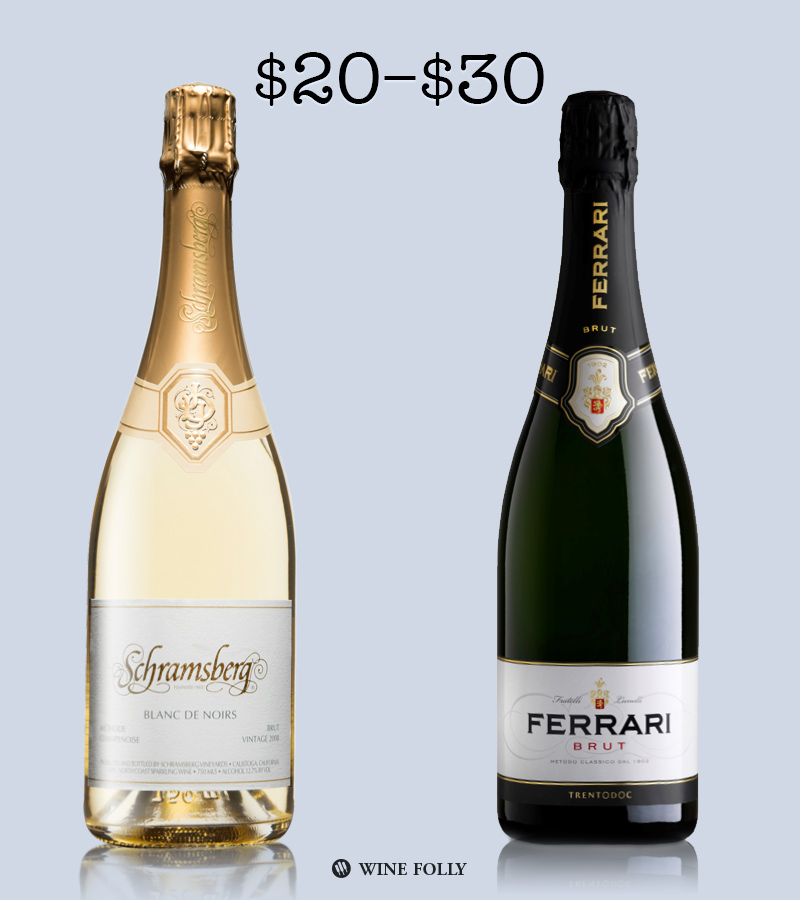
$20–$30 – Getting Sophisticated
What does $10 more get you? It’s about as close as you get to Champagne’s quality without paying for it. As this is a step up, these wines are for events where you need to do precisely that. It’s an impressive wine that impresses. Perfect for your boss’ place, a fancy dinner party, or a sophisticated shindig where seemingly everyone knows something about wine. (Think of sophisticated gatherings or wine-savvy crowds.)
Bonus: You can buy at least one quality cooperative Champagne (What’s a cooperative?) by Nicolas Feuillatte for $29.99. While we have some examples, at this point, it’s useful to do a little extra homework on your smartphone (see tips below).
What You Get: Domestic Sparklers (Good), Reserva or Gran Reserva Cava (Excellent), Crémant (Excellent), Franciacorta (Good), Blanc de Blancs (Great), Sekt (Good)
Some Helpful Tips
- Wine is aged on the lees, and age is a pretty good indication of quality. For example, vintage Champagne must be aged a minimum of 36 months.
- Try the Italian alternatives, including Franciacorta DOCG or Trento DOC. Both are Chardonnay-based sparklers from Italy.
- Look up the varieties used to get a better idea of the taste profile you’re getting.
- Blanc de Blancs or Chardonnay-dominant? Expect more apples, starfruit, beeswax, and honeycomb.
- Blanc de Noirs or Pinot-dominant? Expect white cherry, white raspberry, mushroom, and a touch more funk.
- Macabeo, Xarel·lo, or Parellada? These wines are typically leaner with quince, lime, and green apple notes.
A Few Examples
- Roederer Estate Anderson Valley Brut Sparkling Wine
- Scharffenberger “Excellence” Mendocino County Brut Sparkling Wine
- Domaine Carneros Brut California Sparkling Wine
- Schramsberg “Mirabelle” California Brut Rosé Sparkling Wine
- Ferrari Brut Trento DOC
- Bellavista “Alma Cuvée” Brut Franciacorta DOCG
- Loxarel MM Gran Reserva Brut Nature Cava
- Nicolas Feuillatte “Réserve” Brut Champagne
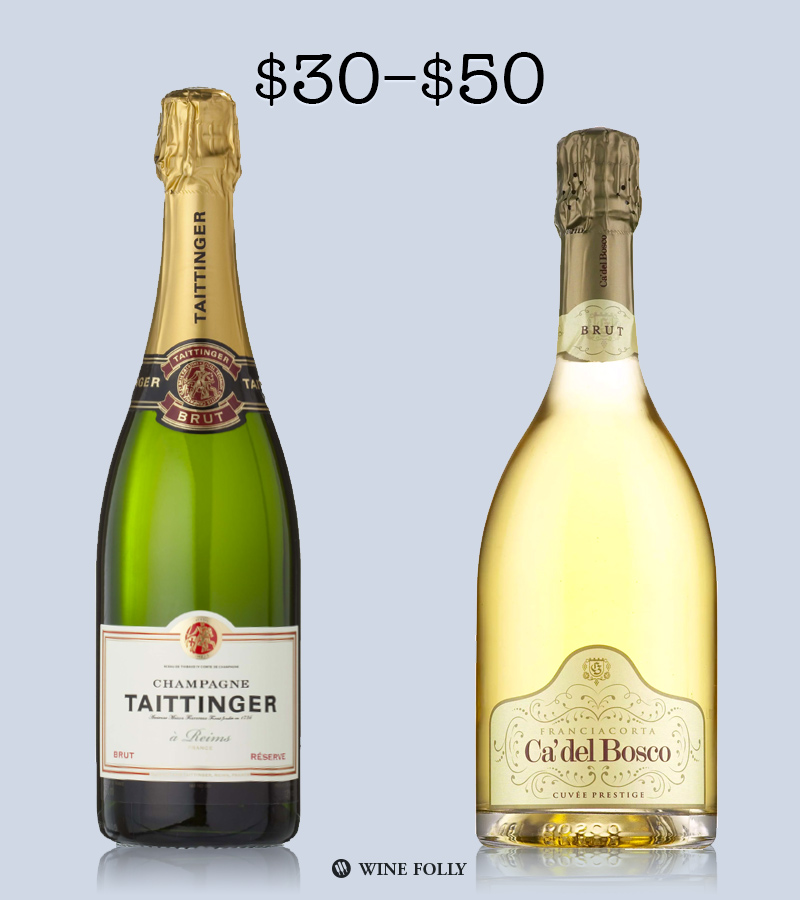
$30–$50 – Brand-Name Champagne
Welcome to the big leagues. Base-model, non-vintage Champagnes from classic houses (such as Veuve Clicquot, Moët & Chandon, Taittinger, and Piper-Heidsieck) are now available to you. However, if you stick to non-Champagne regions, you’re in for a real treat: top-quality, single-vintage, extended tirage truly transcendent wines.
There are also some domestic sparklers at this price point, and they are top-notch. These wines are not just for anyone. They’re for people you care about: partners, parents, siblings, and good friends.
What You Get: Champagne (Base-Model, Non-Vintage), Gran Reserva Cava (Top-Tier), Domestic Sparklers (Excellent), Franciacorta (Excellent), Trento (Excellent)
Some Helpful Tips
- Not sure where to begin? Here are profiles of the biggest Champagne houses:
- Veuve Clicquot: Signature ripe, rich baked apple flavors.
- Moët & Chandon: Fruity, sweetish baked apple and lemon flavors.
- Taittinger: Refined and lean yellow plum, white cherry, and bready notes.
- Piper-Heidsieck: Lean, salty, smoky and clean.
- Deutz: Rich, buttery, marzipan-like flavors.
- Even though you can get good Champagne at this level, Italian Metodo Classico wines from the Italian Alps easily stand up to the big names. Look for Franciacorta from Lombardy or Trento from Trentino-Alto Adige.
- We could go on about Cava (and will), but at this range, you can get top-tier Gran Reserva and all its baked almond and apple-flavored glory.
- Up-and-coming Champagne region to investigate for value: Côte des Bar / Aube
A Few Examples
- Taittinger “Reserve” Brut Champagne
- Deutz “Classic” Brut Champagne
- Louis Roederer Brut “Premier” Champagne
- Moët & Chandon Impérial Brut Champagne
- Ca’ del Bosco “Cuvée Prestige” Franciacorta
- Schramsberg “Blanc de Blancs” Brut North Coast Sparkling Wine
- Altemasi “Pas Dosé” Brut Nature Trento DOC
- Ferrari “Perlé” Trento DOC

$50–$100 – Vintage Territory
This is the pinnacle of Champagne — perfect for celebrating births, milestones, and special moments. If people don’t understand the magnitude of what they’re drinking, it’s your sworn duty to tell them. If you have dear friends who know their wine, break it out. Not only do you start finding vintage Champagne in this price range, but you also get access to some fantastic grower Champagne and amazing non-vintage and rosé Champagne examples. If you have any one of these bottles on hand, life is very good for you, and you should take a minute to acknowledge that.
What You Get: Vintage Champagne (Great to Excellent), Non-Vintage Champagne (Excellent), Blanc de Blancs (Excellent), Blanc de Noirs (Excellent), Grower Champagne (Varies), Premier Cru and Grand Cru Champagne (site-specific expressions)
Some Helpful Tips
- Independent research is crucial at this point. Good places to read free reviews include Decanter and Wine Enthusiast Magazine.
- Depending on the regions in Champagne, there are different styles.
- Montagne de Reims – Classic, rich blends with lots of tertiary notes.
- Côte des Blancs – Home to the top Grand Cru Chardonnay vineyard sites in all of Champagne.
- Vallée de la Marne – Pinot Noir/Meunier dominant region with a funky, mushroom-forward personality. Great for wine geeks.
- Never heard of Grower Champagne? It’s sparkling wine crafted by the same people who grow the grapes. It embodies the style of individual vineyards and those who make the cuvées (sparkling wine blends). Read more about this style here.
A Few Examples
- Bollinger “Special Cuvée” Brut Champagne
- Pol Roger Brut Champagne
- Ruinart “Blanc de Blancs” Brut Champagne
- Tarlant “Cuvée Louis” Brut Champagne
- Hervieux Dumez “Blanc de Blancs” Brut Champagne
- Egly-Ouriet “Tradition” Grand Cru Brut Champagne
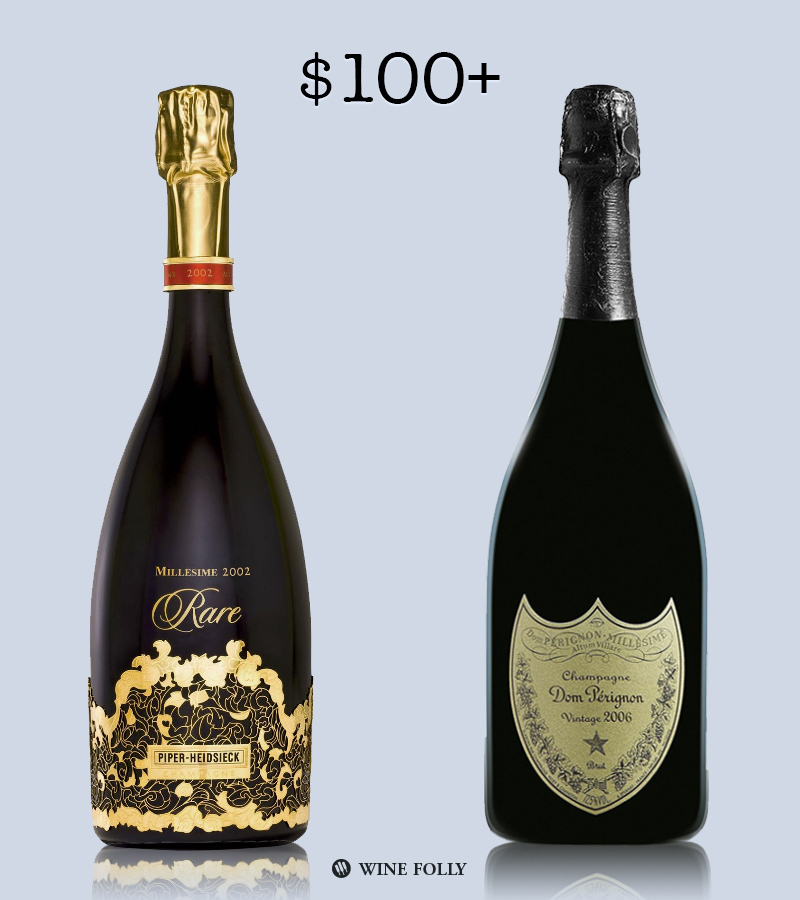
$100+ – Prestige
Oh, we’ve got a badass over here! You did really well this year or so far in this life, and it’s time to take a moment to taste success. Or, at least drink like you’re going to die tomorrow… These are the wines that kings and queens drink. Literally.
In Champagne, they call them “tête de cuvée” or “top of the batch.” They are the most obsessively conceived wines the chef de cave makes. Some producers, like Krug or Salon, only make a tête de cuvée, aging them on tirage (the dead yeast particles called “lees”) up to seven years before they launch in the market. All that time waiting in the cellar is part of the reason these wines are so expensive.
The style of top-dollar Champagnes is often rich, fruity, creamy, and nutty all at once. Of course, you don’t always get this style at this price. Most prominent brands will indeed opt for a toasty, biscuity style. Still, many smaller producers choose to champion the fruit of their Grand Cru vineyard with a leaner style.
So again, read the tasting notes. To give you a leg up, since I know you’ll ask, here are a few brands that consistently deliver an oxidative, leesy, aged Champagne at this price:
A Few Examples
- Veuve Clicquot “La Grande Dame” Brut Champagne
- Billecart-Salmon “Cuvée Nicolas François Billecart” Brut Champagne
- Laurent-Perrier “Grand Siècle” Vintage Brut Champagne
- Piper-Heidsieck “Cuvée Rare” Vintage Brut Champagne
- Nicolas Feuillatte Cuvee Palmes d’Or Vintage Brut Champagne
- Perrier Jouët “Belle Epoque” Brut Champagne
- Cristal by Louis Roederer Vintage Brut Champagne
- Dom Pérignon by Moët & Chandon Vintage Brut Champagne
- Pol Roger “Cuvée Sir Winston Churchill” Vintage Brut Champagne
- Krug Vintage Brut Champagne
- Jacques Selosse “Substance” Blanc de Blancs Vintage Champagne
- Salon Blanc de Blancs Vintage Brut Champagne
The Champagne brands listed are to get you started and represent mostly large, well-distributed wines available in most markets. So, keep searching!

